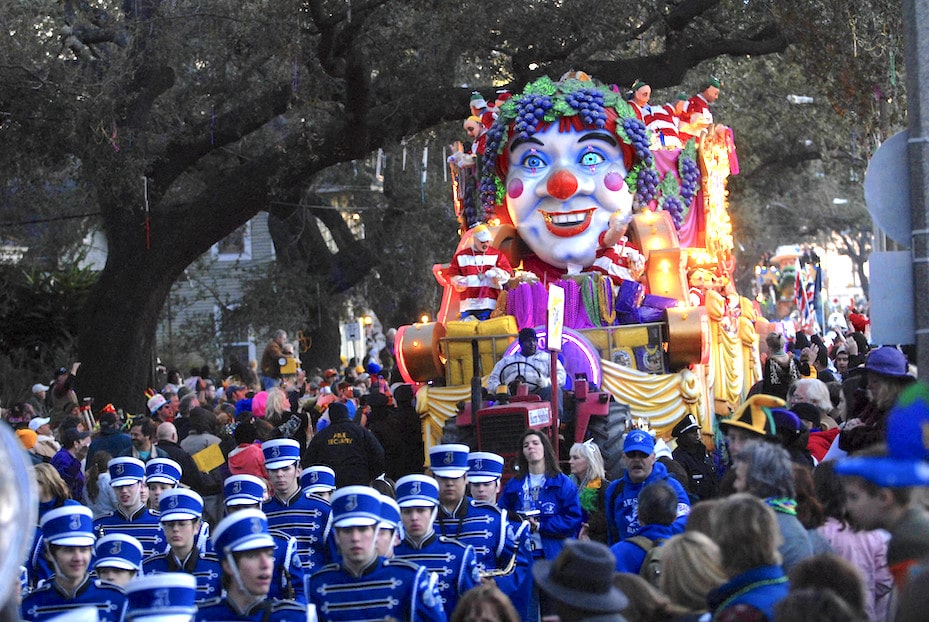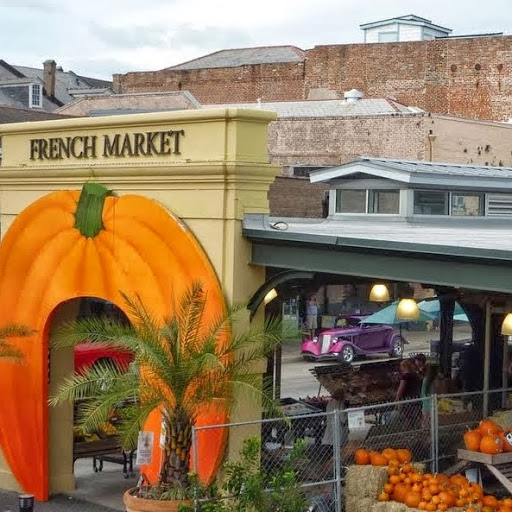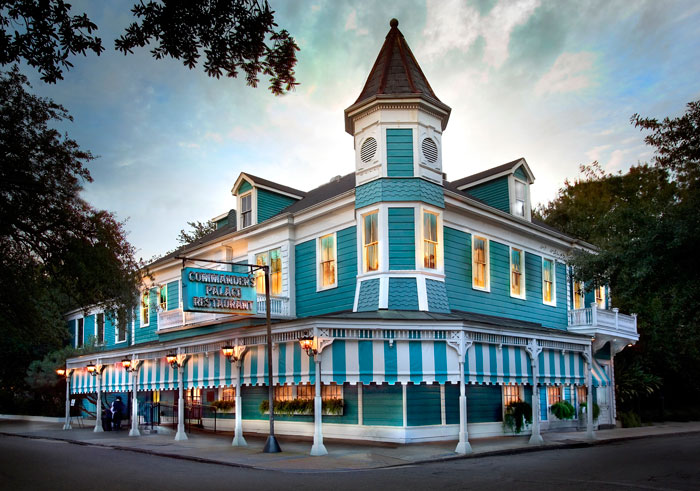
Bacchus float in New Orleans Mardi Gras parade. Photo by Cheryl Gerber
Mardi Gras is on again! New Orleans’ signature event, with its floats, marching bands and more than 40 processions will once again celebrate this city in a way befitting its proud heritage. Festivities start toward the end of February and peak on March 1 when elaborately costumed parades thread their way past jubilant throngs. Along with dancing, jazz and Cajun zydeco , New Orleans also means food. All are tied together through a history of exuberant celebration, Francophone culture and periodic heartbreak.
You can’t appreciate New Orleans without tasting its specialties – hot sauce, gumbo, jambalaya, etouffee and beignets, rice and beans, shrimp and grits. These aren’t tourist clichés, but popular staples that rely on local seafood, sausage and vegetables like tomato and okra. Add to that the flourishing cocktail culture that was born here. Sazerac made with brandy or rye whisky, and locally made bitters, with a rinse of absinthe or Herbsaint is still a signature drink in New Orleans. In fact, in 2008 it was made the official cocktail of Louisiana by the House of Representatives.
The place to start any culinary journey is the famous Café du Monde, on the edge of the Jackson Square, the French Quarter’s large grassy square and site of many spectacles. It’s named after Andrew Jackson but the most prominent statue is that of Jeanne d’Arc on her horse. New Orleans’ French history is evident at every turn – the Fleur de Lys, which has become the symbol of post-Katrina renewal, the street names and many last names.

New Orleans French Market sells excellent local meat and produce. You also can enjoy a cold beer and a muffuletta. Photo by Jacqueline Swartz
The streets bordering Jackson Square are buzzing with cool shops and restaurants. By contrast is Central Grocery, an old school Italian grocery store that has been in the same family since 1906. It’s the mecca for Muffuletta, a sandwich of round Italian bread filled with Mortadella, Genoa Salami, sliced provolone and mozzarella. It’s dressed with a mouthwatering olive salad that includes onions, capers, anchovies, garlic, lemon juice and oregano. One is enough for four people, so Central Grocery sells quarters.
Café du Monde might be a must-see place, but it was crowded, and tourists outnumbered locals. I preferred the beignets (squares of fried dough dusted with powdered sugar) in the intimate and inviting Café Beignet, where the treats were pillow light. The coffee (made with chicory) was distinctively fine, and in the outdoor patio, where musicians sometimes play, you can see the sun filtering through the wrought iron latticework. The low-rise French Quarter, where most tourists stay, gets its visual character from the stucco buildings, wrought iron balconies and courtyards. It’s called Le Vieux Carre and is the oldest part of the city. Fortunately, it’s built on relatively high ground, so for the most part it escaped the Katrina flooding, although some buildings had water damage.

It’s always party time on Jackson Square in the heart of the French Quarter. Photo by Jacqueline Swartz
The most chic street in the French Quarter is Rue Royale, with its galleries, cafes, and boutiques, all one of a kind. Some sell only masks (Mardi Gras is ever-present). On one corner a sign announces Roux Royale, a delightful cookware and cookbook stores. In the window is a huge book of Louisiana Cooking called “Who’s Your Mama: Are You Catholic and Can You Make a Roux”, by Marcelle Bienvenue. The title refers to the fact the original settlers of Louisiana, the Creoles (the word meant original colonists in the new world) were from Catholic countries, mostly France and Spain. Later the word “Creole” came to suggest mixed race
As for the Roux, a mixture of equal parts fat (ranging from butter to bacon drippings) and flour, it’s the basis for much of Creole cooking, along with the so-called “trinity” – onions, celery and green pepper. “Start with a Roux” is the common first step in many Louisiana recipes. Combined with seafood and okra, or chicken and sausage, and thinned with stock, it’s a gumbo. The word means okra in a Bantu language spoken by many of the West African slaves brought to New Orleans.
Jambalaya, a kind of paella, is often thought to come from the French or Spanish word for ham (jambon in French). But no one is sure. By now the influences – French, African, Spanish Cajun – have been mixed together to form a cuisine of their own.
Etouffee, French for “smothered”, is another Roux-based traditional dish. “Make a rich gravy thickened with a dark roux, drop in some crawfish and it looks like you smothered them’, notes Michael de Vidst, a chef who has taught for 22 years at the New Orleans School of Cooking.
I sampled a crawfish etouffee at the famed Acme Grill. It was lunchtime and there was a line down the block, but this bustling, pub-like French Quarter eatery, with its expert veteran staff, didn’t waste a second. The place is famous for its oysters – local, of course – and in addition to the raw ones, I had their famous charcoal-grilled oysters with butter and parmesan. They’re an update of Oysters Rockefeller, which were created at the legendary Antoine’s restaurant in l899.
Another aristocratic French Quarter restaurant is Arnaud’s, founded in 1918. It’s known for its shrimp remoulade, with a mustardy sauce that remains a secret. Once again I noticed that shrimp in New Orleans has a sweet freshness to it, enhanced, in this case, by the soft sounds of a jazz combo.
Until a few decades ago, upscale New Orleans restaurants served mainly French classic cuisine with plenty of butter and cream., notes Michael de Vidts. Then came the Cajun invasion. Foodwise, this took a few hundred years to accomplish. The Acadians came to Louisiana in 1776, fleeing persecution in Canada. But they settled in the western part of the state, not New Orleans. “For the most part, the Cajuns kept to themselves”, says de Vidts, “and had little contact with what was known as the Creole world.”
The Cajuns were poor, and so was their land, although it was ideal for growing rice. They tended to make one-pot dishes like crawfish stew. And they had culinary contact with German immigrants, who brought their sausage-making skills to the new world. As De Vidts explains, “You take the sausage concept and fill it with what you have a lot of – rice – to stretch what you have little of – meat and pork, and you have boudin blanc.”

Located in New Orleans’ Garden District, the Commander’s Palace launched the career of celebrity chef Paul Prudhomme. Photo by Jacqueline Swartz
In the l970’s, Ella Brennan, of the legendary Commander’s Palace restaurant, even then almost a century old, brought a Cajun chef named Paul Prudhomme to New Orleans to add his rustic influence to her menu. Later he opened his own restaurant, K-Paul’s Louisiana Kitchen, and culinary history was made. Prudhomme used andouille, a sausage that is smoked (unlike the one in France by the same name) He blackened redfish, then known as a “garbage” fish. And today, all over town you can find stores selling hot (and other) sauces.
I had a peak dining experience at Commander’s Palace, a multi-room blue-trimmed Victorian building. It’s in the romantic Garden District, a dreamy area of white-columned mansions and oak trees dripping with Spanish moss.
The chef, Tory McPhail, won the 2013 James Beard Award for best chef in the South. And the Food Network featured the restaurant in a challenge: cook the signature dishes of famous alumnae, including Paul Prudhomme and Emeril Lagasse. “Prudhomme brought Cajun food to New Orleans, and Lagasse popularized it”, notes de Vidts.
Amid the witty opulence – chandeliers of wood and crystal, grey and white wallpaper, service that seemed choreographed – I and my companions had some of the dishes made in the contest. We feasted on Jamie Shannon’s Wild Louisiana white shrimp, Tasso ham, pickled okra, sweet onions, five-pepper jelly, and Crystal hot sauce buerre blanc. Chef Tory McPhail’s Crispy Soft Shell Crab is a warm salad of lump blue crab with tomatoes, cucumbers, avocado, roasted corn and grilled shallots. Chef Prudhomme’s Black Skillet Seared Fish came with asparagus, melted leeks, Louisiana soybeans, roasted corn, shaved fennel, and coconut-corn soubise with habanero-chili butter. This is traditional New Orleans food kicked up many notches, not just with hot sauce but with skill and imagination.

Krewe of Freret member Kelly Jackson throws beads to the crowd gathered along an avenue in uptown New Orleans. The Krewe paraded for more than 40 years until the mid-1990s. In 2011, they reorganized and created a unique parade favoring local vendors and craftspeople. Members also hand-decorated Mardi Gras Masks. Photo by Louisiana Office of Tourism
The restaurant is a symbol of the city’s joie de vivre and culinary skill, which will continue, as long as the good times roll.![]()
East-West News Service contributor Jacqueline Swartz also has profiled Athens, Montreal and Baden Baden.

